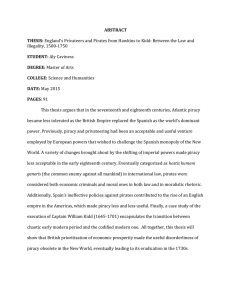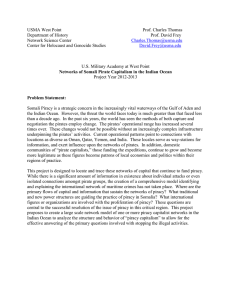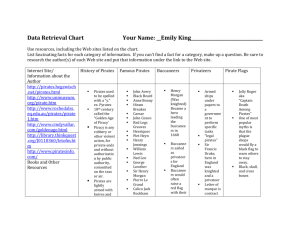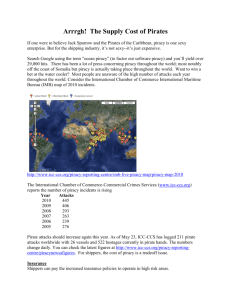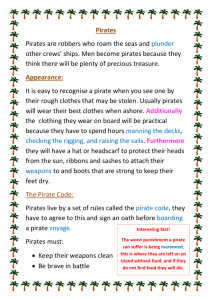HISTORY OF PIRACY
advertisement
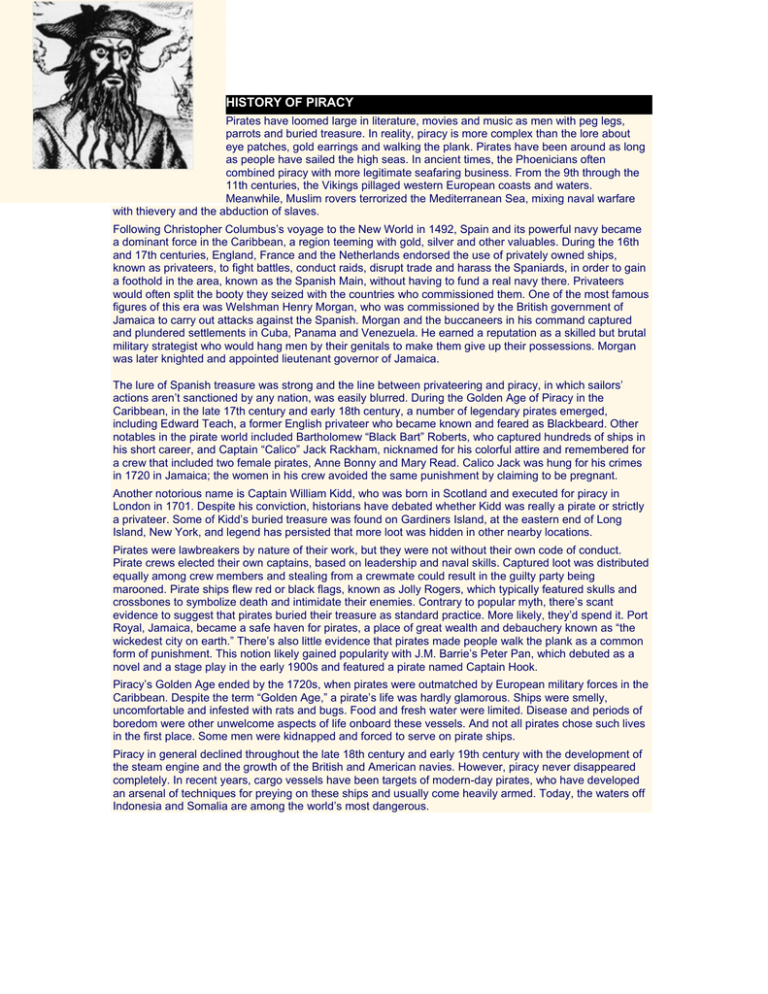
HISTORY OF PIRACY Pirates have loomed large in literature, movies and music as men with peg legs, parrots and buried treasure. In reality, piracy is more complex than the lore about eye patches, gold earrings and walking the plank. Pirates have been around as long as people have sailed the high seas. In ancient times, the Phoenicians often combined piracy with more legitimate seafaring business. From the 9th through the 11th centuries, the Vikings pillaged western European coasts and waters. Meanwhile, Muslim rovers terrorized the Mediterranean Sea, mixing naval warfare with thievery and the abduction of slaves. Following Christopher Columbus’s voyage to the New World in 1492, Spain and its powerful navy became a dominant force in the Caribbean, a region teeming with gold, silver and other valuables. During the 16th and 17th centuries, England, France and the Netherlands endorsed the use of privately owned ships, known as privateers, to fight battles, conduct raids, disrupt trade and harass the Spaniards, in order to gain a foothold in the area, known as the Spanish Main, without having to fund a real navy there. Privateers would often split the booty they seized with the countries who commissioned them. One of the most famous figures of this era was Welshman Henry Morgan, who was commissioned by the British government of Jamaica to carry out attacks against the Spanish. Morgan and the buccaneers in his command captured and plundered settlements in Cuba, Panama and Venezuela. He earned a reputation as a skilled but brutal military strategist who would hang men by their genitals to make them give up their possessions. Morgan was later knighted and appointed lieutenant governor of Jamaica. The lure of Spanish treasure was strong and the line between privateering and piracy, in which sailors’ actions aren’t sanctioned by any nation, was easily blurred. During the Golden Age of Piracy in the Caribbean, in the late 17th century and early 18th century, a number of legendary pirates emerged, including Edward Teach, a former English privateer who became known and feared as Blackbeard. Other notables in the pirate world included Bartholomew “Black Bart” Roberts, who captured hundreds of ships in his short career, and Captain “Calico” Jack Rackham, nicknamed for his colorful attire and remembered for a crew that included two female pirates, Anne Bonny and Mary Read. Calico Jack was hung for his crimes in 1720 in Jamaica; the women in his crew avoided the same punishment by claiming to be pregnant. Another notorious name is Captain William Kidd, who was born in Scotland and executed for piracy in London in 1701. Despite his conviction, historians have debated whether Kidd was really a pirate or strictly a privateer. Some of Kidd’s buried treasure was found on Gardiners Island, at the eastern end of Long Island, New York, and legend has persisted that more loot was hidden in other nearby locations. Pirates were lawbreakers by nature of their work, but they were not without their own code of conduct. Pirate crews elected their own captains, based on leadership and naval skills. Captured loot was distributed equally among crew members and stealing from a crewmate could result in the guilty party being marooned. Pirate ships flew red or black flags, known as Jolly Rogers, which typically featured skulls and crossbones to symbolize death and intimidate their enemies. Contrary to popular myth, there’s scant evidence to suggest that pirates buried their treasure as standard practice. More likely, they’d spend it. Port Royal, Jamaica, became a safe haven for pirates, a place of great wealth and debauchery known as “the wickedest city on earth.” There’s also little evidence that pirates made people walk the plank as a common form of punishment. This notion likely gained popularity with J.M. Barrie’s Peter Pan, which debuted as a novel and a stage play in the early 1900s and featured a pirate named Captain Hook. Piracy’s Golden Age ended by the 1720s, when pirates were outmatched by European military forces in the Caribbean. Despite the term “Golden Age,” a pirate’s life was hardly glamorous. Ships were smelly, uncomfortable and infested with rats and bugs. Food and fresh water were limited. Disease and periods of boredom were other unwelcome aspects of life onboard these vessels. And not all pirates chose such lives in the first place. Some men were kidnapped and forced to serve on pirate ships. Piracy in general declined throughout the late 18th century and early 19th century with the development of the steam engine and the growth of the British and American navies. However, piracy never disappeared completely. In recent years, cargo vessels have been targets of modern-day pirates, who have developed an arsenal of techniques for preying on these ships and usually come heavily armed. Today, the waters off Indonesia and Somalia are among the world’s most dangerous.

